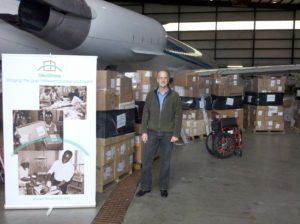At 8:30 this morning an MD-87 filled with over three tons of emergency medical supplies and wheelchairs departed Stockton for a humanitarian aid trip to Haiti. There were also 8 doctors and trauma nurses, a documentary film crew and Wheelchair Foundation (a Division of Global Health & Education Foundation) representatives on board. This is a story of many different groups collaborating together in a short period of time to provide important relief to a country in crisis. We will be periodically providing updates of the trip’s progress and experiences.
 Shortly after the catastrophic 7.0 earthquake devastated Haiti on January 12, 2010, Dan Catullo III, the founder of DC3 Music Group (www.dc3global.com), contacted the Wheelchair Foundation to see if its founder, Ken Behring, would be interested in loaning his private jet to send physicians and medical supplies to that country. He agreed to lend his plane and crew if sponsors could be found for the fuel. Catullo immediately began contacting his associates in the music industry. Scott Stapp, the lead singer for Creed, and New Kids on the Block stepped forward with substantial donations and encouraged other bands to spread the word on their websites.
Shortly after the catastrophic 7.0 earthquake devastated Haiti on January 12, 2010, Dan Catullo III, the founder of DC3 Music Group (www.dc3global.com), contacted the Wheelchair Foundation to see if its founder, Ken Behring, would be interested in loaning his private jet to send physicians and medical supplies to that country. He agreed to lend his plane and crew if sponsors could be found for the fuel. Catullo immediately began contacting his associates in the music industry. Scott Stapp, the lead singer for Creed, and New Kids on the Block stepped forward with substantial donations and encouraged other bands to spread the word on their websites.
Catullo then called Chuck Haupt at Medshare (www.medshare.com), to see if they would donate emergency medical supplies. Haupt responded immediately with 8 pallets of materials like sutures, gauze, syringes, surgical gloves, etc., which are so desperately needed in Haiti. They have been loaded into the cargo section of the plane along with 30 wheelchairs donated by the Wheelchair Foundation. Medshare has also generously agreed to transport another 7 pallets of medical supplies from Atlanta to Fort Lauderdale for the second flight to Haiti. These supplies will be given to Partners in Health (www.pih.org) at the Port-au-Prince General Hospital.
John Muir Hospital in northern California also played a major role in supplying antibiotics and other requested supplies. Jeff Behring, the son of Ken Behring, and Glenn Perry, a longtime supporter of the Wheelchair Foundation, had met Senator Bill Frist at an event the previous week. Frist, a surgeon, had just returned from a week in Haiti and told Jeff what supplies were the most important. When Perry contacted Ben Drew at John Muir, the hospital provided everything on Frist’s list.
You also need a “slot time” to land in Haiti. Phil VanderWilt, the MD-87 pilot, was on the phone most of a day trying to secure a position. He finally got one that was six days away. The plane will land in Fort Lauderdale Wednesday night, pick up more doctors, and head to Haiti. The jet will then be unloaded, extract doctors and specialists from Partners in Health and Direct Relief International that have already been on the ground for a week or so and return to Florida. Two days later it will transport another 16 doctors and two tons of medical supplies to assist in the relief effort. The plane will then depart for California.
The Wheelchair Foundation would like to commend Jeff Behring, Dan Cathullo and Chris Rudd for their tireless efforts and passion in making this project come to fruition. We also want to thank the musical performers and their fans for their invaluable support. The people of Haiti need your help now and into the future to rebuild their lives and their country.
The Wheelchair Foundation is a Division of Global Health & Education Foundation.
